Less stress, less cost but more fun, thanks to China's bullet trains
that connects Beijing and Pingyao and Xian
|
|
|
Beijing-Pingyao-Xi'an-Beijing
All-Bullet Train Tour for One Week
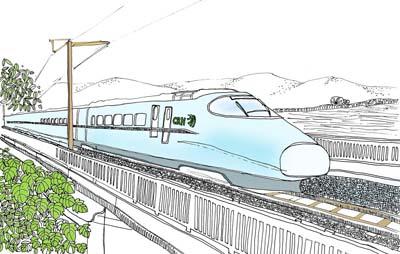 Beijing and
Xi'an probably have the most cultural attractions of all of China. Beijing and
Xi'an probably have the most cultural attractions of all of China.
This package connect Beijing and Xian by adding a stop at
Pingyao, an ancient town famous for its commercial history
in China by taking the advantage of China's developed bullet
train lines.
Usually, the bullet train takes 5-6 hours from Beijing to
Xian or vice versa. Here we break those hours by taking 4
hours to Pingyao from Beijing and 3 hours to Xian from
Pingyao. By adding this stop, you will receive the
following:
• Visit the Terracotta
Warriors, one of the world’s great
archaeological discoveries, as well as other
great sites in Xian, China’s ancient capital.
• Experience the imperial lifestyle at the
Forbidden City, the Summer Palace, the pandas, while also
walking on the Great Wall.
� Visit the largest residential courtyard in China and the
oldest bank in China's history in Pingyao.
B=breakfast;
L=lunch; D=dinner
|
|
|
| |
STANDARD TOUR ITINERARY |
 |
Tour code:
P-BXB |
|
DAY 01 Arrive in Beijing
Upon arrival at the Beijing airport, you
will be me by your local
English-speaking guide, and he will take
you to your hotel, the Tiantan Hotel, a
4 star hotel located in downtown
Beijing. If time permits, we can get
started with some sightseeing, but if
not, you are free to spend the night at
your own leisure, and resting up for the
days ahead.
|
|
DAY 02 Great Wall Adventure (B, L)
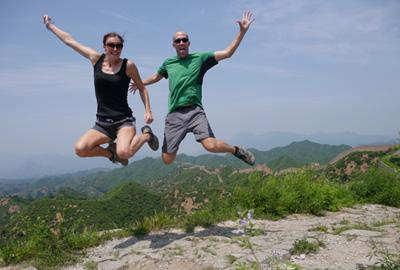
At
8 am you will be picked up from your hotel lobby by your
English-speaking guide and driver. From there we will make
the approximate 2.5 hour drive to the Great Wall at Jinshanling. The Great Wall at Jinshanling is one of the
best preserved parts of the Great Wall with many original
features. It got its name because it was built on the
Greater and Lesser Jinshan (�Gold Mountain�) Ranges. A
tablet with the Chinese inscription for Jinshanling Great
Wall was set into this section. The Jinshanling Great Wall
has not been repaired since 1570. It is a remote and
relatively isolated section of the Great Wall. As there are
relatively few tourists at Jinshanling Great Wall, it is a
good place to explore on foot. Because it is full of
challenge and with splendid and charming
scenery, this section of the Great Wall has been
the favorite destination of hiking lovers from
all over the world.
The
Jinshanling Great Wall was initially built from 1368 to 1389
in the Ming Dynasty (1368-1644), and in 1567 and 1570
rebuilding of the Wall was mainly directed by General Qi
Jiguang (1528-1588). Poems and tablet writings can be found
on the Jinshanling Great Wall left from the time when Qi
Jiguang directed the rebuilding of this section of the Great
Wall. There are more than 100 watch towers along the
Jinshanling Great Wall. �Watching Beijing Tower" is on the
highest point from where you can see Beijing. The Jinshanling Great Wall is second only to the Badaling Great
Wall in its completeness.
You will then be dropped of at the hotel, and
the rest of the evening can be spent at your
discretion.
|
|
DAY 03
Beijing (B, L)
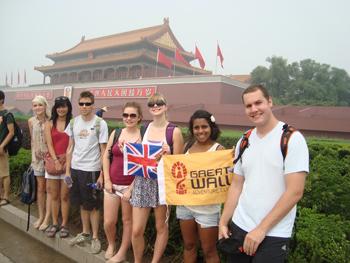 After breakfast in the hotel we will
head over to the center of Beijing,
Tiananmen Square. The largest public
square in the world, Tiananmen Square is
seen as China’s political center. Its
grounds have seen some turbulent
moments, from the May 4th Movement of
1919 to the political turmoil of 1989.
The south of the square is marked by the
Chairman Mao Memorial Hall, while the
center of the square is dominated by the
Monument to the People’s Heroes, an
imposing 10-story granite obelisk. To
the east is the National Museum of
China, and to the west is the Great Hall
of the People, home to China’s
legislative bodies. The north of the
square is dominated by the Gate of
Heavenly Peace, known for its iconic
portrait of Mao Zedong, and is the
national emblem of China. After breakfast in the hotel we will
head over to the center of Beijing,
Tiananmen Square. The largest public
square in the world, Tiananmen Square is
seen as China’s political center. Its
grounds have seen some turbulent
moments, from the May 4th Movement of
1919 to the political turmoil of 1989.
The south of the square is marked by the
Chairman Mao Memorial Hall, while the
center of the square is dominated by the
Monument to the People’s Heroes, an
imposing 10-story granite obelisk. To
the east is the National Museum of
China, and to the west is the Great Hall
of the People, home to China’s
legislative bodies. The north of the
square is dominated by the Gate of
Heavenly Peace, known for its iconic
portrait of Mao Zedong, and is the
national emblem of China.
After walking across the street, we will
enter what is perhaps the greatest
attraction in China, the Forbidden City.
After walking across the square we will
enter the Forbidden City (known in
Chinese as Gu Gong), the largest
surviving palace complex and the former
home of the emperors of the Ming and
Qing Dynasty. The Forbidden City is one
of the greatest attractions in the
world. Built by the third Ming emperor
between 1406-1422, the Forbidden City
served as the official residence to the
Emperor of China until the last emperor, Puyi, was forced to evacuate in 1924.
The Forbidden City is divided into two
parts. The southern section, or the
Outer Court was where the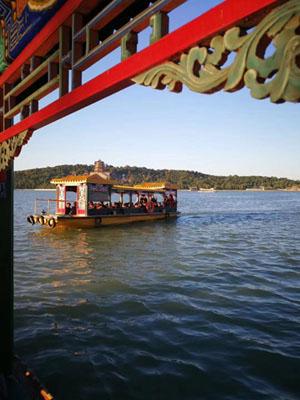 emperor
exercised his supreme power over the
nation. The northern section, or the
Inner Court was where he lived with his
royal family. Consisting of 980
buildings and with 8,707 bays of rooms,
the Forbidden City is the best example
of classical Chinese architecture in the
world, and is a wonder to behold. emperor
exercised his supreme power over the
nation. The northern section, or the
Inner Court was where he lived with his
royal family. Consisting of 980
buildings and with 8,707 bays of rooms,
the Forbidden City is the best example
of classical Chinese architecture in the
world, and is a wonder to behold.
After lunch you’ll have the opportunity to
walk inside the Summer Palace located northwest of the city center. Having
the largest royal park and being well
preserved, the Summer Palace is ranked
amongst the most noted and classical
gardens of the world. In 1998, UNESCO
listed it as one of the World Heritage
Sites. Like most of the gardens of
Beijing, it could not elude the rampages
of the Anglo-French allied force of 1860
and was destroyed by fire. In 1888,
Empress Dowager Cixi embezzled navy
funds to reconstruct it for her own
benefit, changing its name to Summer
Palace (Yiheyuan). She spent most of her
later years there, dealing with state
affairs and entertaining.
Highlights not to be missed are climbing
Longevity Hill, viewing the Empress
Dowager Cixi’s extravagant Marble Boat,
and talking a walk down Suzhou Jie, a
canal meant to resemble the beautiful
southeast watertown of Suzhou by Shanghai.
You will return to your hotel around 6 pm.
|
DAY 03
Beijing (B, L)
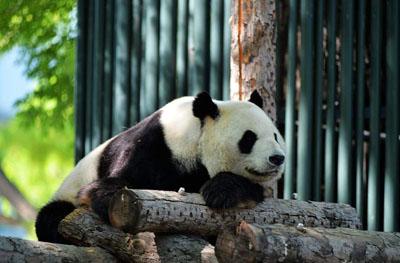 Today you will have tours to visit giant pandas
in Beijing in the morning. The Beijing Zoo
exhibits the wild and rare animals of China.
Outside of traveling to Sichuan, Beijing zoo is
the best place in China to view the Giant Panda.
With those charming black patches around the
eyes & ears and a customary pot belly, they are
just too cute to ignore and the giant pandas are
truly recognized as the national icon of China. Today you will have tours to visit giant pandas
in Beijing in the morning. The Beijing Zoo
exhibits the wild and rare animals of China.
Outside of traveling to Sichuan, Beijing zoo is
the best place in China to view the Giant Panda.
With those charming black patches around the
eyes & ears and a customary pot belly, they are
just too cute to ignore and the giant pandas are
truly recognized as the national icon of China.
After visiting the zoo we will go to visit the
Lhama Temple. Other than the ones in Tibet
this is the best Buddhist temple in Beijingand
in China. Work on the Lhama Temple originally
began in 1694 during the Qing dynasty. It served
as an official residence for court eunuchs. It
was then converted into the home of the Prince
Yong, a son of the Kangxi Emperor and himself
the future Yongzheng Emperor. It was converted
into a lamasery after his ascension to the
throne in 1722. Today the Lhama Temple still
functions as a monastery and temple of the Geluk
School of Tibetan Buddhism. Walking through the
temple your senses will be enveloped by the
incenses and the chanting of the visiting monks
and other followers. The rear Pavilion of Ten
Thousand Happinesses features a 26m tall statue
of the Maitreya Buddha cared from a single piece
of white sandalwood. It is one of three artworks
in the Lhama Temple that were included in the
Guiness Book of World Records, and it is not to
be missed on your visit.
After the gourmet lunch of Beijing's taste, we will embark on a
rickshaw tour of Beijing hutongs. Hutongs are
courtyard homes groupedtogether around narrow
alleys, and served as the lifeline and center of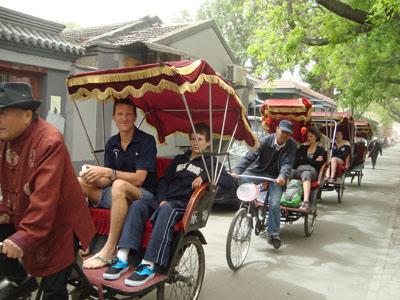 everyday life in old Beijing. The hutongs were a
critical component in the development and evolution
of Beijing folklore and culture. Going on this
hutong tour, you will feel like you have traveled
back in time to a far different China, one where
there was still an emperor sitting in the Forbidden
City, and where there was still enough time to enjoy
the simple pleasures of common life.
everyday life in old Beijing. The hutongs were a
critical component in the development and evolution
of Beijing folklore and culture. Going on this
hutong tour, you will feel like you have traveled
back in time to a far different China, one where
there was still an emperor sitting in the Forbidden
City, and where there was still enough time to enjoy
the simple pleasures of common life.
After exploring the hutongs we will conclude our
tour with a visit to the Lotus Market of Beijinjg. The Lotus
Market is a pleasant pedestrian-only street on Houhai (the back lakes), which features traditional
crafts, bars, restaurants, and entertainment for all
ages. Rambling along the back lakes is a perfect way
to top off your tour, and the gentle breezes off the
lakes will soothe you after the long day. Afterward,
we will drive you back to your hotel, with your tour
with us coming to an end.
|
|
DAY 04 Beijing-Pingyao
 This morning you
will take the Bullet Train G627 (8:00 am to
11:59 am) from Beijing to Pingyao. Your driver
will transfer you from your hotel at 6:30 am to
Beijing West Train Station. Your local guide in
Pingyao will meet you at the Pingyao Train
Station. This morning you
will take the Bullet Train G627 (8:00 am to
11:59 am) from Beijing to Pingyao. Your driver
will transfer you from your hotel at 6:30 am to
Beijing West Train Station. Your local guide in
Pingyao will meet you at the Pingyao Train
Station.
Situated 676 kms north
of Beijing, Pingyao is linked firmly to a
certain prosperous time in Chinese history. It
played quite
an important role in the economic development of Shanxi during the
Ming and Qing Dynasties. Pingyao was the birthplace of the Jin
Businessmen, who were one of the two dominant Chinese business groups
during the Ming (1368-1644) and Qing (1644-1911) dynasties. Owing to
this, the first Chinese exchange shop was opened in Pingyao. Then,
for the next hundred years, Pingyao was home to almost all of the
large exchange shops in China. To a certain degree, Pingyao was to
China during the eighteenth century what Wall Street is to the US,
which not only helped promote the economic development of Shanxi,
but also left us with a magnificent old city and a series of grand
residences.
Pingyao has now become quite a hot tourist attraction even though it
is no longer economically prosperous. It boasts the famous Pingyao
Old City which was included in the United Nations World Cultural
Heritage in 1997. From the top of the grand City Wall, you have a
bird's-eye view of the Old City, a complete city built almost a
thousand years ago. In the Ancient Ming and Qing Street, you can
experience the town's former glory while exploring the rows of
residences and shops all constructed in the original architectural
style.
After a gourmet
lunch, you will spend the entire afternoon to
visit Rishenchang Piaohao Bank
Museum. It is the first bank ever established in
China. "Rishengchang" literally translates to
"Sunrise Prosperity", and "Piaohao" means draft
banks, predecessors of modern banks in China.
You will walk on one of China's oldest city wall
perfectly kept. The City Wall has a history of
2700 years. You will also pick up the City God
Temple, the most beautiful Taoist Temple in
China, the Confucius Temple in the streets of
Ming and Qing Dynasties. In the end, you will
have a 30-minute free class to learn China's
civil arts of paper-cutting.
Tonight's hotel features the historic and
traditional culture where used to be the big
residence of a famous family. The courtyard and
the rooms are filled in with Chinese-style
furniture.
|
DAY 05 Pingyao-Xian
(B,L)
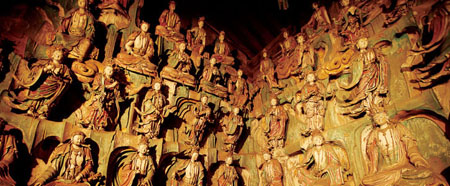 After
breakfast, we will visit the Shuanglin Temple,
the last place to tour before we head to Xian.
Founded in the 6th century, the temple is
notable for its collection of more than 2,000
decorated clay statues that are dated to the
12th-19th centuries. It is nicknamed the museum
of colored sculptures. Most of them are dated to
the period of the Song, Yuan, Ming and Qing
dynasties. After
breakfast, we will visit the Shuanglin Temple,
the last place to tour before we head to Xian.
Founded in the 6th century, the temple is
notable for its collection of more than 2,000
decorated clay statues that are dated to the
12th-19th centuries. It is nicknamed the museum
of colored sculptures. Most of them are dated to
the period of the Song, Yuan, Ming and Qing
dynasties.
The bullet train D2511
to Xian is at 10:42
am. It's short trip for only
three hours. At 1:41 pm, your guide in Xian will
meet you at the Xian North Train Station and
drive you to the downtown to tour the Drum
Tower, Muslim Quarter and the City Wall of Xian.
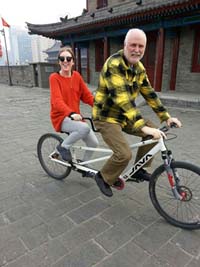 Xi�an
is one of the only cities where the old city
walls are still standing. The wall now stands 12
meters (40 feet) tall, 12-14 meters (40-46 feet)
wide at the top and 15-18 meters (50-60 feet)
thick at the bottom. It covers 13.7 kilometers
(8.5 miles) in length with a deep moat
surrounding it. Every 120 meters, there is a
rampart which extends out from the main wall.
The length and width of the Wall are good enough
for you to rent a bike and ride on the Wall. Xi�an
is one of the only cities where the old city
walls are still standing. The wall now stands 12
meters (40 feet) tall, 12-14 meters (40-46 feet)
wide at the top and 15-18 meters (50-60 feet)
thick at the bottom. It covers 13.7 kilometers
(8.5 miles) in length with a deep moat
surrounding it. Every 120 meters, there is a
rampart which extends out from the main wall.
The length and width of the Wall are good enough
for you to rent a bike and ride on the Wall.
Tonight, you will be treated Xian's unique
dumpling banquet following by Xian's famous Tang
Dynasty Dance Show.
It was here in Xian
that the art of creating the most tasty and
delicate of dumplings was refined and no visit
to the city is complete unless you partake of a
Dumpling Dinner.
This is an experience for the
dumpling connoisseur, the flavors, shapes and
colors will tempt the palette, while the elegant
names and stories attached to each variety are
truly amazing. It is no less amazing that a
simple way of preparing food has become so very
popular and sophisticated that it is now
considered to be as much a work of art as a
tasty morsel. 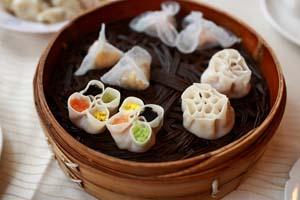
The
Tang Dynasty Music and Dance Show is an
outstanding exponent of this ancient stable and
prosperous society, keeping alive its splendid
culture and providing an insight into the
peaceful life style of the period. As an art
form, the show has its roots in folk fetes, when
dances were first performed by people as part of
rituals of prayer for a good harvest or a better
life. Combining poetry with the skilled playing
of musical instruments, singing, dancing and
also stunning costumes, the modern presentation
is certain to give you an impressive view of
ancient China including its splendid history,
brilliant arts, distinct traditions and customs.
You will stay overnight in Xian at Ramada
Hotel, a four-star hotel in downtown.
|
DAY 06 Xian (B, L)
Today
is the highlight of your Xian tour - visiting
the Terracotta Warriors, a World Heritage site.
The Terra Cotta Warriors
and Horses Museum is the result of the
most significant archeological
excavations of the 20th century. Work is
ongoing at this site, which is around
1.5 kilometers east of Emperor Qin Shi
Huang's Mausoleum. It is a sight not to
be missed by any visitor to China. Upon
ascending the throne at the age of 13
(in 246 BC), Qin Shi Huang, later the
first Emperor of all China, had begun to
work for his mausoleum. It took 11 years
to finish. It is speculated that many
buried treasures and sacrificial objects
had accompanied the emperor in his after
life. A group of peasants uncovered some
pottery while digging for a well nearby
the royal tomb in 1974. Life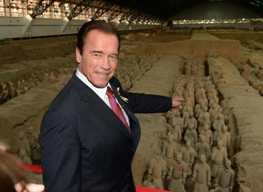 size
terracotta figures of warriors and
horses arranged in battle formations are
the star features at the museum. They
are replicas of what the imperial guard
should look like in those days of pomp
and vigor. size
terracotta figures of warriors and
horses arranged in battle formations are
the star features at the museum. They
are replicas of what the imperial guard
should look like in those days of pomp
and vigor.
The museum is divided into three
sections: No. 1 Pit, No. 2 Pit, and No.
3 Pit respectively. They were tagged in
the order of their discoveries. No. 1
Pit is the largest, first opened to the
public on China's National Day, 1979.
There are columns of soldiers at the
front, followed by war chariots at the
back. No. 2 Pit, found in 1976, contains
over a thousand warriors and 90 chariots
of wood. It was unveiled to the public
in 1994. Archeologists came upon No. 3
Pit also in 1976. It is the command
center of the armed forces. It went on
display in 1989, with 68 warriors, a war
chariot and four horses.
After lunch by the Museum,
you will be on the way to return to Beijing on
Bullet Train G666 at 4:00 pm. You will arrive in
Beijing at 9:41 pm. A driver will be waiting for
you to transfer you to your hotel.
|
|
DAY 07 Beijing (B)
Following breakfast, you will be driven
to the Beijing airport, where you will
catch your flight to your next
destination, ending your tour with Great
Wall Adventure Club.
|
|
|
Package includes:
1.Pickup service
between airport to hotel.
2.The transportation between scenic spots
3.Five nights accommodation based on two persons sharing one standard
room in the four star hotel
4.Soft-sleeper round way train tickets from Beijing to Xi’an.
5.Professional local guide
6.Meals indicated in the itineraries
7.General admission tickets
|



 emperor
exercised his supreme power over the
nation. The northern section, or the
Inner Court was where he lived with his
royal family. Consisting of 980
buildings and with 8,707 bays of rooms,
the Forbidden City is the best example
of classical Chinese architecture in the
world, and is a wonder to behold.
emperor
exercised his supreme power over the
nation. The northern section, or the
Inner Court was where he lived with his
royal family. Consisting of 980
buildings and with 8,707 bays of rooms,
the Forbidden City is the best example
of classical Chinese architecture in the
world, and is a wonder to behold. Today you will have tours to visit giant pandas
in Beijing in the morning. The Beijing Zoo
exhibits the wild and rare animals of China.
Outside of traveling to Sichuan, Beijing zoo is
the best place in China to view the Giant Panda.
With those charming black patches around the
eyes & ears and a customary pot belly, they are
just too cute to ignore and the giant pandas are
truly recognized as the national icon of China.
Today you will have tours to visit giant pandas
in Beijing in the morning. The Beijing Zoo
exhibits the wild and rare animals of China.
Outside of traveling to Sichuan, Beijing zoo is
the best place in China to view the Giant Panda.
With those charming black patches around the
eyes & ears and a customary pot belly, they are
just too cute to ignore and the giant pandas are
truly recognized as the national icon of China. This morning you
will take the Bullet Train G627 (8:00 am to
11:59 am) from Beijing to Pingyao. Your driver
will transfer you from your hotel at 6:30 am to
Beijing West Train Station. Your local guide in
Pingyao will meet you at the Pingyao Train
Station.
This morning you
will take the Bullet Train G627 (8:00 am to
11:59 am) from Beijing to Pingyao. Your driver
will transfer you from your hotel at 6:30 am to
Beijing West Train Station. Your local guide in
Pingyao will meet you at the Pingyao Train
Station. 

 Xi�an
is one of the only cities where the old city
walls are still standing. The wall now stands 12
meters (40 feet) tall, 12-14 meters (40-46 feet)
wide at the top and 15-18 meters (50-60 feet)
thick at the bottom. It covers 13.7 kilometers
(8.5 miles) in length with a deep moat
surrounding it. Every 120 meters, there is a
rampart which extends out from the main wall.
The length and width of the Wall are good enough
for you to rent a bike and ride on the Wall.
Xi�an
is one of the only cities where the old city
walls are still standing. The wall now stands 12
meters (40 feet) tall, 12-14 meters (40-46 feet)
wide at the top and 15-18 meters (50-60 feet)
thick at the bottom. It covers 13.7 kilometers
(8.5 miles) in length with a deep moat
surrounding it. Every 120 meters, there is a
rampart which extends out from the main wall.
The length and width of the Wall are good enough
for you to rent a bike and ride on the Wall.

 size
terracotta figures of warriors and
horses arranged in battle formations are
the star features at the museum. They
are replicas of what the imperial guard
should look like in those days of pomp
and vigor.
size
terracotta figures of warriors and
horses arranged in battle formations are
the star features at the museum. They
are replicas of what the imperial guard
should look like in those days of pomp
and vigor.